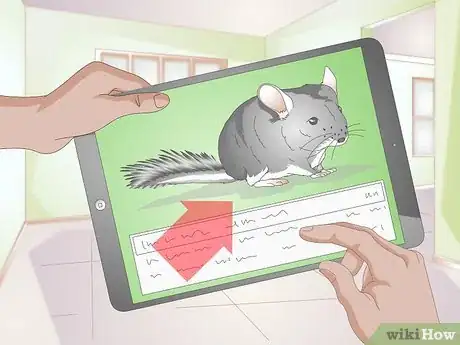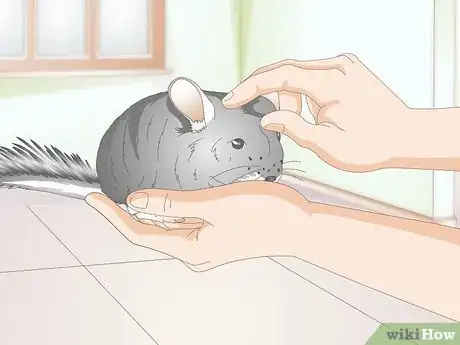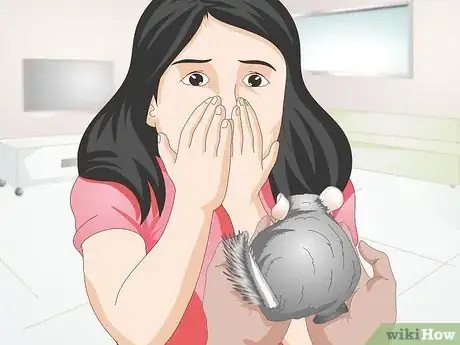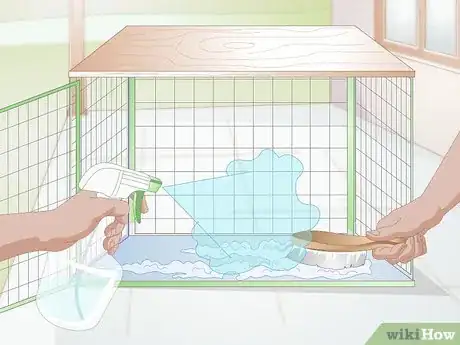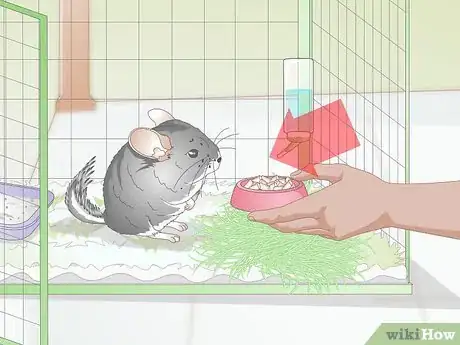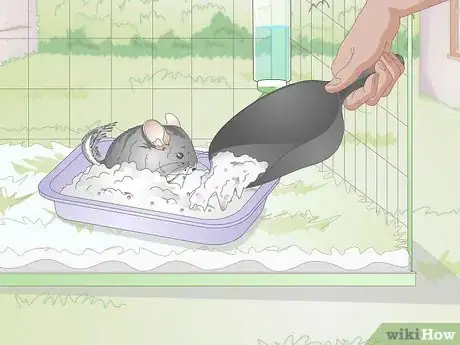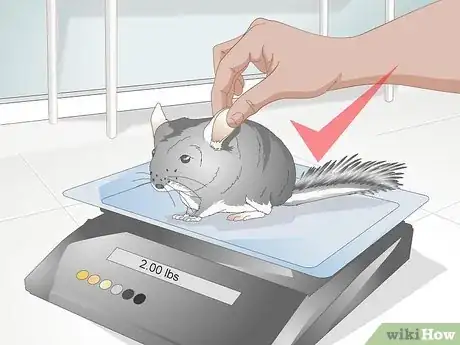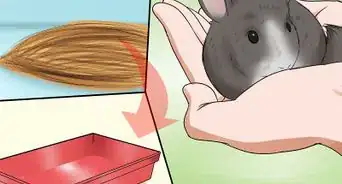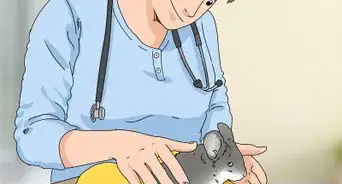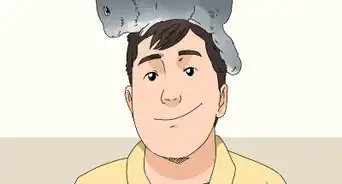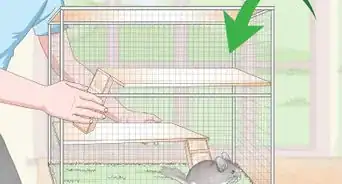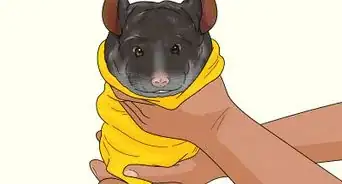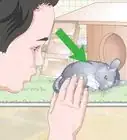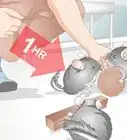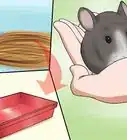This article was co-authored by wikiHow Staff. Our trained team of editors and researchers validate articles for accuracy and comprehensiveness. wikiHow's Content Management Team carefully monitors the work from our editorial staff to ensure that each article is backed by trusted research and meets our high quality standards.
This article has been viewed 32,607 times.
Learn more...
Buying a new chinchilla can be an exciting experience, especially when you've never owned one of these adorable friends before! Learning as much as possible about these animals and setting up a healthy and comfortable environment for them to live in can help ensure that your chinchilla will have a long and happy life.
Steps
Preparing for a Chinchilla
-
1Learn about chinchillas. You need to be prepared before you buy one of these unique and exotic pets. Read as much as you can about can about these furry creatures to be sure that they are the right pet for you.
- Consult websites dedicated to chinchillas and reach out to owners - perhaps a friend who has a chinchilla - to get first hand accounts of what it's like to own one.
- Become knowledgeable about the needs of a pet chinchilla, their diet, socializing habits, nocturnal lifestyle, and their daily exercise needs.
- Be sure that you understand the full responsibilities of owning these creatures, the commitments, and the sacrifices you will need to make to ensure your pet will have a healthy and long life. Chinchillas can live as long as 15-20 years, and they are a long-term commitment. They are unique pets that require care which is different from more common pets such as cats or dogs.
-
2Look for the right veterinarian. You need to make sure that if your new chinchilla gets sick, you have a professional who can help heal it. The vet should be certified to treat 'exotic pets.'
- Consult the Association of Exotic Mammal Veterinarians to find listing of vets that treat chinchillas.[1]
- Contact your local veterinarians to ask about their experience with chinchillas. Find a vet office that you can trust and are comfortable with.
- Inquire about costs for chinchilla related services. You will be responsible for paying the vet bills which can be surprisingly expensive.
Advertisement -
3Purchase an appropriate cage. This will serve as the home and environment for your chinchilla. A cage should fit the following specifications:[2]
- Chinchillas need a wire cage, otherwise they will be able to chew through it. They can overheat in an enclosed space like an aquarium. The wire should not be coated with plastic or paint, because it will be ingested by the chinchilla.
- A mesh bottom is not recommended, because a chinchilla's feet can get caught in it, leading to injuries. If it does have a mesh shelf, the spaces should not be more than ½ inch apart.
- The cage should be large enough for a chinchilla to exercise. A chinchilla that can run and play is a happy chinchilla.
- Chinchillas' ideal temperature is 68°F. Keep the cage in a draft free place in the winter. In the summer, your pet may need an air conditioner to keep it cool.
-
4Get additional supplies. You will need to furnish the cage to make it a comfortable home for your chinchilla as well as have food ready for when you bring your pet home. These supplies can be bought at your local pet supplies store.
- Bedding to line the bottom of the cage.
- Timothy hay.
- Chinchilla food, in the form of pellets.
- Food bowl and drip bottle.
- Exercise wheel.
- Dust and dust bath.
- Treats and chews.
- Toys.
Acquiring a Chinchilla
-
1Make sure the chinchilla is healthy. When you visit an adoption center or a breeder, check to see that the chinchilla is being well-taken care of. They should have a solid, clean coat, shiny black eyes, and be living in a clean and comfortable cage with plenty of food.
-
2Consider adopting. There are many chinchillas who are looking for a good home. Search for a chinchilla rescue center online, or contact the local RSPCA.
- Sadly, many chinchillas are put to sleep every year due to a lack of housing.
- A benefit of adopting is that your chinchilla will be older, tame, and trained in certain skills - a lot of the hard work has already been done for you!
- Adopting from an established rescue center will mean that your chinchilla is in the hands of caring people who are dedicated to caring for and finding a good home for these abandoned pets.
-
3Find a respected breeder. Read online reviews for local breeders and pick one with a good reputation. You will have the advantage of seeing the chinchilla awake in the evening, in their home environment. The breeder can share expert knowledge about a particular chinchilla and you can see its parents.
- A good breeder will offer to deliver your chinchilla and double check that you have set up a good environment for their new home.
- Chinchillas come in many different colors, and purchase price will be based on color variations and fur quality.
-
4Buy from the local pet shop. You will need to make sure the chinchilla is being well cared for and healthy.
- If the pet shop does not allow you to handle the chinchilla during daytime, look into the cage to see how it is living.
- Ensure that they are happy to let you handle the chinchilla under their supervision before taking it home. If they are not, leave and find a different store where they will let you check a chinchilla's health and well-being.
Caring for a Chinchilla
-
1Clean up after the chinchilla. Cage bedding, or hay, should be changed weekly, and the entire cage cleaned and disinfected once a month. Do this with soap and warm water.
-
2Feed your pet pellets and hay. A chinchilla will eat about 2 tablespoons of pellets per day. Replenish the cage with fresh hay daily. Treats can be store bought, or Cheerios, whole wheat pasta, or rose buds.
- Chinchillas will not overeat and should always have pellets and hay available.
- They should be provided with specialty chinchilla pellets. Do not buy pellets made for other animals like rabbits or guinea pigs, these pellets do not contain the correct nutrition that a chinchilla needs.
-
3Refill the drip bottle with fresh water daily. This is absolutely crucial to keeping a healthy chinchilla. Stale water can grow algae and fungus and make your pet sick. Just as you wouldn't drink old water, chinchillas need clean water every day.
- Do not use water directly from the tap. It should be filtered or boiled and cooled completely before put in the drip bottle.
- Keep in mind that your chinchilla likely will not drink all the water in the bottle in one day. This does not mean you should wait until the bottle is empty, water should be replaced daily!
-
4Exercise your pet daily. Remove your chinchilla from the cage for 30-60 minutes of daily exercise. Turn off any noise, like the TV, and allow the chinchilla to come to you.
- When outside of its cage, do not let the chinchilla out of your sight. They can be mischievous critters with a tendency to chew anything from books to electrical wires. They can burrow and quickly become lost.
-
5Dust bathe. Chinchillas should never get their fur wet, as it will cause to clump and tangle. In their natural environment, chinchillas roll in volcanic ash to clean their fur.
- Chinchilla dust is available at pet stores, although some small pet supply stores may not carry it. Try a larger chain such as PetCo, or order online. A two pound jar of dust costs about $10. Chinchillas only need a small amount to bathe in, so it should last for a while.
- Make available a small bowl filled with dust for the chinchilla to “bathe” in.
- Fill container such as a biscuit tin, goldfish bowl, or tupperware box with a thin layer of dust. Keep in mind that the container should be big enough for a chinchilla to roll around in.
- Allow the chinchilla to bathe in the dust for 15 minutes every other day, or at least twice a week.
- Replace the dust once it has become dark colored or grainy.
- Chinchillas may be sensitive to dust and make nose clearing sounds, or watery eyes. If the chinchilla seems particularly sensitive, switch to a different brand.
-
6Observe your pet's health. Chinchillas are prey animals, which means they will hide their symptoms until it is often too late. A healthy animal is active and alert, eats and drinks regularly, has healthy fur and walks normally. Look out for symptoms like weight and hair loss, lethargy, eye or nasal discharge, as they can be signs of sickness. Conduct a weekly examination of your chinchilla.
- Check the animal's weight. Weight loss is one of the first symptoms of sickness.
- Ear ailments are uncommon, but if you notice fluid coming coming out, or issues with balance, contact a vet immediately.
- The nose should be clean and dry, with no discharge. Missing fur from around the nose can indicate a fungal infection such as ringworm.
- Drooling or pawing at the mouth can mean tooth issues. Teeth should be straight, even, and unchipped. Providing your chinchilla with plenty of hay and chew toys should keep their teeth in food shape and stop them from overgrowing.
- Droppings are a strong indicator of your pet's health. Chinchillas poo frequently, and their droppings should be dark brown or brown-black, dry, firm, plump, slightly moist, rounded or oval and solid. Irregular droppings can be a sign of digestive problems.
Community Q&A
-
QuestionAre chinchillas clean pets that are good with secondary school kids?
 WikiHowUser20180706164259Community AnswerIt depends on your definition of "clean." They poop a lot, but they don't smell bad (in my opinion). If you are talking about as a class pet, no. That many kids would be stressful, and stress can kill. If you're thinking about getting one for your own child(ren), you know what responsibilities your kids can handle, but at that age you are the main caretaker. Caring for them usually takes 1-2 hours a day if they are in a pair. Do some research on their care before making a decision.
WikiHowUser20180706164259Community AnswerIt depends on your definition of "clean." They poop a lot, but they don't smell bad (in my opinion). If you are talking about as a class pet, no. That many kids would be stressful, and stress can kill. If you're thinking about getting one for your own child(ren), you know what responsibilities your kids can handle, but at that age you are the main caretaker. Caring for them usually takes 1-2 hours a day if they are in a pair. Do some research on their care before making a decision. -
QuestionIs it dangerous to put a cage near a wire, seeing as they chew often?
 WikiHowUser20180706164259Community AnswerYes. They should not be able to reach anything outside their cage. Wires should also not be in playtime areas.
WikiHowUser20180706164259Community AnswerYes. They should not be able to reach anything outside their cage. Wires should also not be in playtime areas. -
QuestionCan I have multiple chinchillas at once?
 Community AnswerProvided you can afford to care for them and have the time to spend with them, then yes. Chinchillas are usually herd animals, so it is best for them have a companion or two of their own species.
Community AnswerProvided you can afford to care for them and have the time to spend with them, then yes. Chinchillas are usually herd animals, so it is best for them have a companion or two of their own species.
Warnings
- Be sure to get your chinchilla from a reputable source, whether a shelter, breeder, or pet shop, to support the ethical treatment of animals.⧼thumbs_response⧽
References
About This Article
To buy a chinchilla, find a reputable breeder by reading online reviews. Search online for a rescue center or contact the local branch of the RSPCA instead if you'd rather adopt one. You can also visit a local pet store to purchase a chinchilla, provided they let you handle it first. While you're holding it, check that it has a solid coat, black eyes, and clean living environment, which are all signs of good health. If the store won't let you handel the chinchilla, find somewhere else to make your purchase. For tips from our Veterinary co-author on how to take care of a chinchilla, keep reading!
